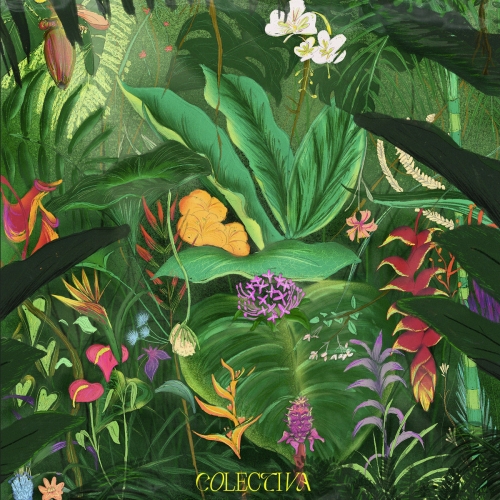Artist:
dal:um
Title:
Coexistence
Year Of Release:
2024
Label:
tak til
Genre:
World
Quality:
FLAC 24-Bit/48 kHz; 16-Bit/44.1 kHz; MP3 320 kbps
Total Time: 00:37:54
Total Size: 94; 156; 373 MB
WebSite:
Album Preview
al:um - alongside peers Park Jiha, Jambinai and Leenalchi - are at the forefront of a new Korean music. The duo of Ha Suyean and Hwang Hyeyoung are virtuosos on two different types of traditional zithers, the gayageum and geomungo, and their music deftly navigates a plethora of contemporary influences: minimalism, experimental folk and abstract jazz.
The sound of 21st century Seoul, where the boundaries of tradition
are stretched and occasionally broken.
Coexistence is released on tak:til, Glitterbeat’s instrumental music imprint, and home to artists such as Brìghde Chaimbeul, Širom, Jon Hassell and Park Jiha.
Something magical is happening on the South Korean music scene, and it isn’t K-Pop. Blow away the froth, and it is soon apparent that in the concert halls and clubs of Seoul and beyond, a febrile music scene is bubbling up. The Dal:um duo are at the forefront of new Korean music, bringing a questing, modernising energy to timeless traditions.
Ha Suyean and Hwang Hyeyoung grew up learning formal Korean gugak music, excelling on two different types of zithers: the gayageum and geomungo respectively. But these two young women soon became restless. Dal:um is the sound of 21st century Seoul, where the boundaries of tradition are stretched (and occasionally broken) to create something unique.
Dal:um translates as ‘to keep pursuing something’, a name which couldn’t be more apposite. Suyean and Hyeyoung garnered wide acclaim and toured around the world with their debut album, Similar and Different (Tak:til/Glitterbeat, 2021), and with their second album, Coexistence, they are taking another leap forward.
Similar and Different was the sound of two musicians pushing and pulling one another. In Coexistence they have become one: one with one another, one with the wider world around them, one with life itself. It is music that is deeply personal, but personal in the way that it absorbs the life that surrounds the pair, finding peace, fear, drama and – ultimately - hope.
Coexistence was forged at the tail end of the COVID pandemic. The duo, who first met as members of the Seoul Metropolitan Youth Traditional Music Ensemble, determined that this time round they would compose the whole album themselves. They took inspiration from the nature around them in Seoul, as well as from their tours in Europe, where long car journeys took them through natural landscapes that were strikingly different from home. “The pandemic made us realise how precious the things around us truly are,” they explain. “As we wrote, we contemplated the value of living alongside other living things. The question that arose was: how can we harmoniously coexist with the life surrounding us? We wanted to encapsulate these thoughts in our music.”
Recording in Seoul’s A&Tive Studio, Suyean and Hyeyoung resisted the temptation to add unnecessary bells and whistles to their music, sticking resolutely to the dynamic between their two instruments. Both the gayageum and the geomungo are made of long, rectangular blocks of Paulownia wood with strings strung across them. Each string is arched over a moveable wooden bridge at a different point along the length of the instrument. The 25-string gayageum is typically the more melodic and lyrical of the pair, lending itself to repeated undulating melodies. The geomungo is its more boisterous cousin. The bamboo-stick plectrum struck against its six thick strings produces the thrilling thwack and twang that is so distinctive in Korean music. Hyeyoung also brings a novel approach to the instrument by sawing at the strings with a bow, creating a scratchy wave of noise during the music’s most intense moments.
We can hear both instruments at their fullest on the opening number, ‘DOT’. A manifesto of sorts, it has the precision and urgency of morse code brought to life. In their words: “We were focussing on the 'dot' as a musical motif characteristic of string instruments. The expanding pattern of these dot motifs in both the gayageum and geomungo symbolises the continuous progress of Dal:um.”
Further into the album, ‘Dodry’, calls upon the duo’s musical education by incorporating elements of ‘Suyeonjangjigok’, a piece from Korea’s Joseon era that was used to pray for the longevity of the king. The title comes from dodry, the traditional Korean musical form that is similar to the repeat sign in Western music. In this piece Dal:um reflect on the daily routines which accumulate to shape who we are. With the strings ringing out in sustained notes, it is radical in its starkness and has the elegance of a Chopin nocturne.
The inspiration for another number on Coexistence is the work of English visual artist Cornelia Parker, whose fascination with opposites and transformations led to her mixing snake poison and its antidote with black and white inks. The interplay between the gayageum and geomungo on the track ‘Poison and Antidote’ finds the two musicians seemingly clawing at one another, then coming together to represent the writhing serpent itself. Equally evocative is the closing track, which was written in response to the television documentary My Octopus Teacher (Pippa Ehrlich & James Reed, 2020), which followed a diver in South Africa. ‘In the Deep’, reflects what the duo describe as a “beautiful yet fierce’ underwater ecosystem, the enquiring strings questioning humanity’s place in nature.”
Like the sea, on the surface this album stretches to the horizon with rippling, translucent patterns. The duo’s symbiotic connection and instrumental mastery is both awesome and strangely reassuring. Those who dive deeper will find that the album has a beautiful yet fierce ecosystem of its own. All life is to be found here. Near and far. Old and new. Fear. Hope. All… in coexistence.
Tracklist:
1 Dot
2 Cracking
3 Dodry
4 Poison and Antidote
5 Alive
6 In the Deep




![Grises - Eveil (2025) [Hi-Res] Grises - Eveil (2025) [Hi-Res]](https://www.dibpic.com/uploads/posts/2025-12/1766127968_cover.jpg)





